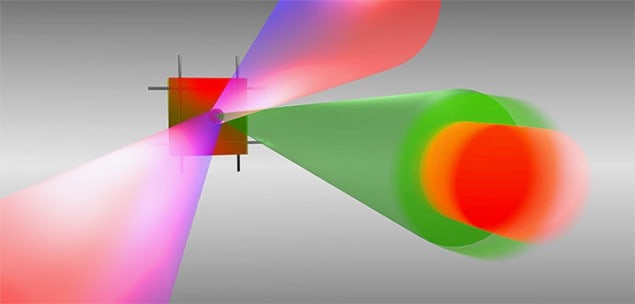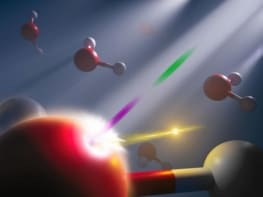
Physicists in Sweden have come up with a new way of accelerating ions using intense laser pulses. The technique – which has not yet been tested in the lab – involves bouncing “chirped” pulses from a mirror and promises to deliver much more intense ions beams than existing laser acceleration schemes. With further development, the method could be used to provide high-energy ions for cancer treatment.
Beams of ions with energies in the 100–200 MeV range are ideal for treating some cancers because they can be fine-tuned to deposit most of their energy within a tumour, thereby minimizing the damage to nearby healthy tissue. Conventional ion therapy, however, requires big, expensive accelerators and beam-guiding systems, which means that relatively few hospitals have such facilities.
Ions can, however, also be accelerated to high energies by firing intense laser pulses at a target, which could lead to smaller and less expensive treatment facilities. The process involves a laser pulse creating a hot plasma in which the heated electrons expand rapidly away from the target, leaving the much more sluggish ions behind. Eventually, a huge electric field builds and this will accelerate ions in the plasma to very high energies.
This process is very inefficient and messy, however, and produces ions with a wide range of energies – which is not ideal for cancer therapy. And, because the process is essentially a thermal effect, a large increase in the power of the laser is required to achieve a modest increase in the average energy of the ions.
Sailing away
One way of improving the process is to use a “light sail” – a thin reflective metal foil that is very good at absorbing energy from the laser pulse. However, this technique suffers from instabilities arising from how the light sail is impacted by the laser pulse. What Felix Mackenroth, Arkady Gonoskov and Mattias Marklund from the Chalmers University of Technology have instead done is accelerate ions by placing a similar thin foil target next to a thick mirror.
Their technique involves firing a laser pulse through the foil target and onto the mirror. The light bounces off to create a standing wave in the region of the foil, with light pressure pushing on both sides of the foil, thereby stabilizing it as the plasma is created. Electrons in the plasma are attracted to the first minimum of the standing wave, which is located in front of the foil. As a result, the electrons are accelerated towards the source of the laser light. This creates a huge electric field that in turn accelerates the ions in the same direction.
Clever chirp
At this point, a clever trick is used to enhance the acceleration process. Instead of using a laser pulse with a fixed wavelength, the team proposes the use of a chirped pulse with a wavelength that changes continuously. Mackenroth, Gonoskov and Marklund have shown that by carefully selecting the chirp, the location of the first standing wave minimum will move away from the foil and mirror – dragging the electrons with it and further accelerating the ions.
Mackenroth told physicsworld.com that ion energies of about 100 MeV should be achievable using the technique. However, he admits that the acceleration technique will produce ions with an energy distribution that is too wide for medical applications, which need monoenergetic beams. To create such a beam, ions of the right energy would then have to be selected by bending the original ion beam with a magnet, which would increase the overall size of the system.
Higher energy
On the upside, the energy distribution of the ions created in the chirped technique is narrower than that of the light sail. It also produces as many as 1000 times more ions, which means that after energy selection is done, there should still be enough ions left over for medical applications. Another benefit of the technique is that it can produce more higher-energy ions than other methods. Furthermore, the energy of the ions can be adjusted by changing the chirp of the pulse, which can easily be done.
“With our method we can capture, stabilize and organize large numbers of ions with great precision without using a lot of energy,” says Mackenroth. “This is a small step towards the ultimate goal of treating cancer tumours in a way that provides enormous benefit to society. But we are still far from the ultimate goal.” Mackenroth adds that the technique will soon be tested in the lab.
The proposal is described in Physical Review Letters.



